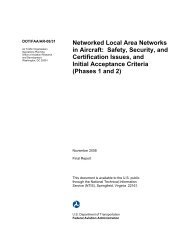Published Report (DOT/FAA/CT-94-36)
Published Report (DOT/FAA/CT-94-36)
Published Report (DOT/FAA/CT-94-36)
Create successful ePaper yourself
Turn your PDF publications into a flip-book with our unique Google optimized e-Paper software.
provided by ARTS displays, FMA's provide controllers with<br />
features to aid them in the early detection of blunders and the<br />
control of airspace. These include independent axes expansion<br />
capabilities, color coding, aircraft predictor lines, and audio<br />
and visual warnings.<br />
With FMA's, vertical and horizontal (Y-X) axes can be expanded<br />
independently, in accordance with site variable requirements, to<br />
improve the controller's ability to detect aircraft movement away<br />
from the extended runway centerline. For this simulation, the<br />
ratio for the horizontal axis was 6 times, while the vertical<br />
axis was 1.5 times on the controllers' displays.<br />
For each of the three runways, ILS approach centerlines were<br />
displayed as dashed white lines, where each dash and each space<br />
between dashes were scaled to represent 1 nmi. Additional solid<br />
light blue lines were on each side of the ILS centerline to<br />
delineate 200 foot-deviations from the localizer. The 2000-ft<br />
wide NTZ, between extended runway centerlines, was outlined in<br />
red.<br />
A predictor line was used in the generation of the audio and<br />
visual alerts. The predictor line, which was affixed to each<br />
aircraft target, indicated where the aircraft would be in 10 s if<br />
it continued on the same path. The predictor line provided the<br />
controller with advance notice of the path of the aircraft. The<br />
predictor line can be varied, but for this simulation it was set<br />
to 10 s.<br />
Aircraft targets and alphanumeric data blocks were presented in<br />
green, as long as they maintained an approach within the normal<br />
operating zone (NOZ). When the predictor line indicated that an<br />
aircraft was within 10 s of entering the NTZ, the green aircraft<br />
target and data block changed to yellow. An auditory warning<br />
also sounded (e.g., llAmerican 211") to notify the controller of<br />
the impending NTZ entry. If the aircraft entered the NTZ, the<br />
yellow aircraft target and data block immediately changed to red-<br />
2.2.3 Fliaht Simulators and Simulator Parameters.<br />
Six Part 121 aircraft simulators and one general aviation trainer<br />
(GAT) were integrated into the simulation. This group included<br />
simulators from: NASA-Ames, Moffett Field, CA; AVIA Inc., Costa<br />
Mesa, CA; Boeing Inc., Seattle, WA; Trans World Airlines, St.<br />
Louis, MO; Delta Airlines Inc., Atlanta, GA, and the <strong>FAA</strong><br />
Technical Center, Atlantic City International Airport, NJ.<br />
Having the flight simulators as an integral part of the<br />
simulation increased the validity of the findings by providing a<br />
representative sample of NAS users (i.e., currently licensed<br />
airline pilots who staffed the simulators). It also generated<br />
more accurate data with respect to aircraft and pilot<br />
performance.

















